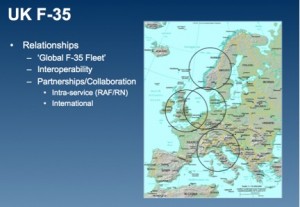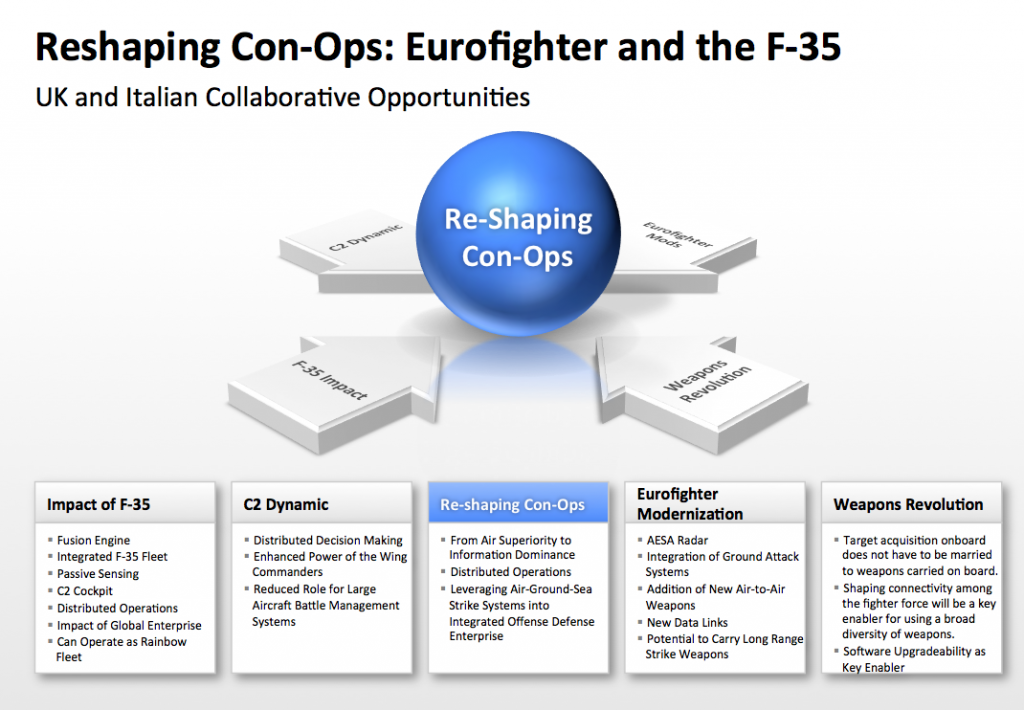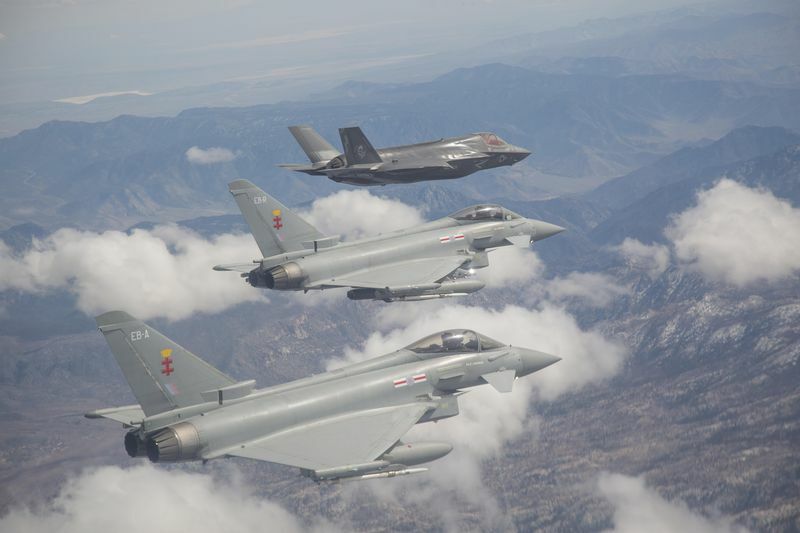2015-05-15 By Robbin Laird
At the Copenhagen Airpower Symposium, a major theme was the impact of the F-35 on the transformation of airpower for the smaller or medium sized air forces.
The coming of the F-35 was gaining momentum, and now those airpowers which are procuring the F-35, are thinking through the impact of the fifth generation aircraft on their legacy fleets.
This impact is described variously as the integration of the 4th and 5th generation aircraft, or the transformation of airpower, or shaping a new ecosystem for fifth generation enabled operations.
Two core presentations at the symposium were those by Air Vice-Marshal (Retired) John Blackburn and Lt. Col. “Chip” Berke, the fifth generation USMC pilot with significant legacy air experience.
Blackburn focused on the RAAF’s Plan Jericho which has been triggered by the decision to buy the F-35.
The significant advances the F-35 offers to the combat force needs to be matched by similar type of advances in situational awareness an the ability to operate as a team across the whole force.
How are we going to use our legacy systems, and those new platforms we are bringing into the force in an innovative way to shape new capabilities and concepts of operations?
From our dealings with the Marines in Australia and elsewhere, it was obvious that they were thinking along similar lines.
The Marines are truly joint in the Australian terms, and like us, they are not waiting for new systems to come into play prior to shaping a new approach to combat innovation.
They are shaping the template as new platforms – in this case the F-35 comes into play.
They have put several years of work into thinking about and doing combat innovations prior to the F-35 entering their force.
This is the way we are approaching the challenge and opportunity as well.
And for Berke, the F-35 is a disruptive change asset which was driving a change on the eco system for 21st century warfare.
He highlighted the synergy between the plane and the emerging fleet and the fifth-generation enabled combat ecosystem.
Berke used the iPhone analogy to describe the dynamics of change.
When Steve Jobs introduced the iPhone he said it was revolutionary for it combined a computer, with a music player, with a phone.
And he repeated this several times in the roll out presentation.
I doubt that anyone in the audience today would describe their iPhone that way.
The ecosystem which grew up around the phone and with which the phone itself has matured, is what is revolutionary, not simply the phone. The same is true of the F-35; it is revolutionary; but the ecosystem which will change and which will inform the further development of the aircraft is even more so.
In other words, the F-35, notably the global fleet of F-35s, will drive strategic change in the entire approach to warfighting.
But this means as well, that it is about the reshaping of the roles and tasks of legacy assets as well as the addition of new assets that further develop the 21st century warfighting template.
It is not simply about adding yesterday’s systems; it is about crafting new ones, which fit into the evolving warfighting template.
At the heart of this transition clearly are the weapons which empower today’s force, are being adopted by the F-35 or enabled by the F-35, and those which will be added to the 21st century fleet to deal with evolving threats.
The UK has certainly suffered from significant funding shortfalls and with the current election seem hell bent on avoiding any discussion of defense and its central importance to the viability of the United Kingdom, one can be forgiven if the evolving template for change being crafted by the RAF might be missed.
Looking back at the time of Lord Drayson as procurement minister announced the formation of Team Complex Weapons. Naturally, this effort has largely been focused upon in terms of weapons procurement and development.
As the then head of MBDA UK put it in an article published by RUSI in 2010:
It was the publication of the UK MoD’s Defence Industrial Strategy (DIS) in December 2005 that encouraged the UK Complex Weapons (CW) industry and counterparts in MoD to face up to the need for a different approach to the acquisition and support of CW in the future.
The combination of declining investment in CW, the stated need to retain appropriate operational sovereignty of CW through the retention of sovereign industrial capabilities, together with new requirements for enhanced military capabilities, demanded a new sector-wide approach.
Team CW was formed by industry in 2006 in response to the challenge, and is now under the joint leadership of UK MoD and MBDA, with Thales Air Defence, Thales Missile Electronics, Roxel and QinetiQ as members. In the two years of the Team CW Assessment Phase (AP), significant progress has been made both on the six launch projects, and in testing the benefits of a Portfolio approach towards the acquisition of CW, through the development of a family of weapons.
The benefits from commonality, modularity and technology re-use, amongst other initiatives, have been measured to provide evidence to inform an MoD Main Gate investment decision relating to partnering in the CW sector.
A largely unintended consequence of this decision was positioning the UK for a sweet spot with regard to 4th/5th generation airpower transition.
For the focus on a rationalized weapons stockpile being developed for an integrated fleet (integration extending to naval as well as air breathing platforms) has laid a foundation for addressing ways to shape 21st century combat capabilities as well.
There are five elements which can be clearly identified whereby the complex weapons approach is part of the transformation of the RAF and the Royal Navy.
First, when one visits HMS Queen Elizabeth, a significant innovation is the weapons loading system.
The HMS Queen Elizabeth in common with CVN-78 has a new way to load weapons and to configure the weapons loads to enhance the safety and speed of the weaponization process.
There is a highly mechanized weapons handling system and advanced machinery automation.
The weapons are brought to either end of the deck to be loaded onto the combat aircraft; and the mechanism for loading and moving the weapons can provide for a mix and match capacity to push the proper loads to the particular aircraft for the missions of the day.
In fact, the system aboard the HMS Queen Elizabeth can prepare those loads the night before the early morning missions.
The UK approach to building a complex weapons enterprise means that there is a common stockpile supporting the strike force.
This means that the numbers and types of weapons have been necked down and the introduction of new weapons will again be built around commonality which will allow the carrier to optimize its ability to arm the strike force as well.
In contrast to a US carrier that can have upwards of 50 weapons in the stockpile, the UK carrier will have a much smaller stockpile of weapons to choose from but with the wide variety of effects one would want from those weapons.
With the common training and software between the RAF and USMC F-35Bs, certification for cross weaponization is certainly a clear possibility moving forward as well.
The common pool of weapons in support of the F-35 is an important enabler for a resupply effort as well, whereby as the UK operates its carrier forward it could receive weapons from foreign stockpiles of common weapons as well.
Second, the F-35 as a scout can leverage the other combat aircraft which will be in the RAF inventory from 2020 onwards, namely the modernized Typhoon.
There is commonality and overlap between the weapons to go onboard the F-35 and the Typhoon, which will enhance the lethality of the fleet in terms of common stockpiles, training and operations.
The commonality delivered by the complex weapons enterprise is a core element for shaping overlap between the Eurofighter and the F-35 and enhancing the overall capabilities of the combined air fleet.
Third, the Eurofighter is upgradeable as the weapons enterprise evolves.
The current planned modernization whereby a new radar and weapons management tools are installed into the cockpit will allow the Eurofighter to subsume many of the Tornado missions, but as well given the kinetic differences from the operation of the two aircraft, the Eurofighter will bring new strike capabilities to the common stockpile between Tornado and Eurofighter as well.
Fourth, as the Eurofighter evolves through weaponization, and is operated as such by the UK and Italy, the Eurofighter can emerge as a clear legacy partner to the F-35.
Both the UK and Italy will cross learn and cross buy weapons for enabling their combined Eurofighter and F-35 fleets, and as such will place operational integration of the two aircraft via the weapons enterprise as an important centerpiece for the way ahead.
And this will allow as well, those countries transitioning to an all F-35 fleet, can through common weapons also connect to the way ahead being forged by the UK and Italy as well.
In Group Captain Paul Godfrey’s presentation to the Copenhagen Airpower symposium, he highlighted this possibility in the following slide:

Fifth, the coming of the F-35 also facilities a new relationship between the air fleet and the naval surface fleet.
Clearly, as the UK carrier becomes operational, one opportunity is to link the Type 45 destroyer to the F-35 in an offensive-defense strike capability.
As this happens, the ability to modify air delivered weapons to operate aboard the ships of the surface navy will provide multiple strike points from which the overall integrated force can deliver effects.
And the complex weapons approach will facilitate this.
For example, SPEAR 3 could operate from an air platform or from a surface ship and the key is for the forward deployed C2 asset to be able to cue strike in order to ensure the desired kinetic effects.
In short, the synergy among the new carrier, the complex weapons enterprise, the coming of the F-35 and the modernization of the Eurofighter can be significant.
And the UK working relationships with other European air forces, notably that of Italy’s, can provide a catalyst for change in the decade ahead.
Editor’s Note: For a broader look at the weapons revolution, see the following:
https://www.sldinfo.com/the-f-35-allies-and-global-investments-in-21st-century-airpower/
https://www.sldinfo.com/building-a-21st-century-weapon-the-case-of-the-meteor-missile/



